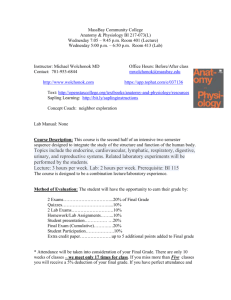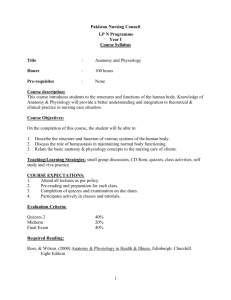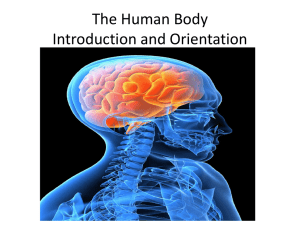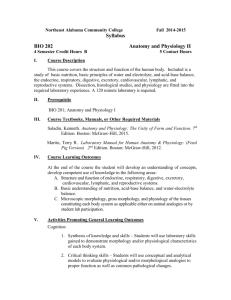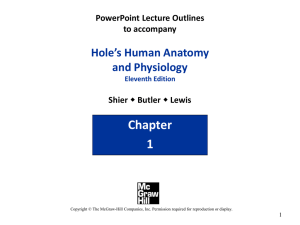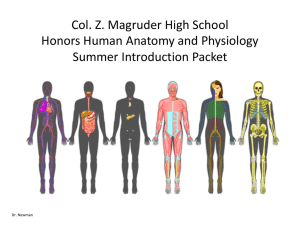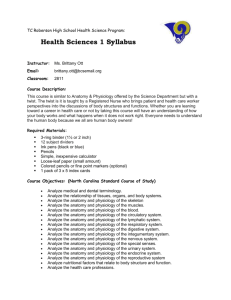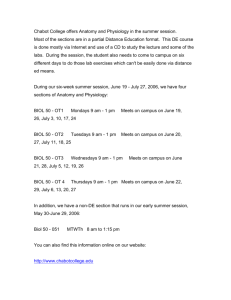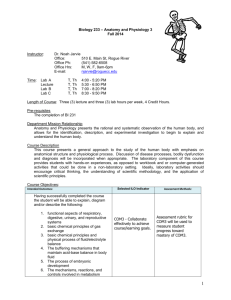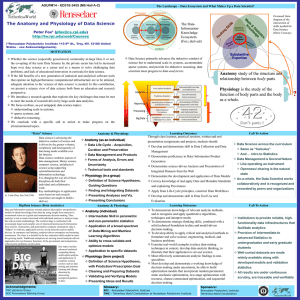SUSSEX COUNTY COMMUNITY COLLEGE ANATOMY
advertisement
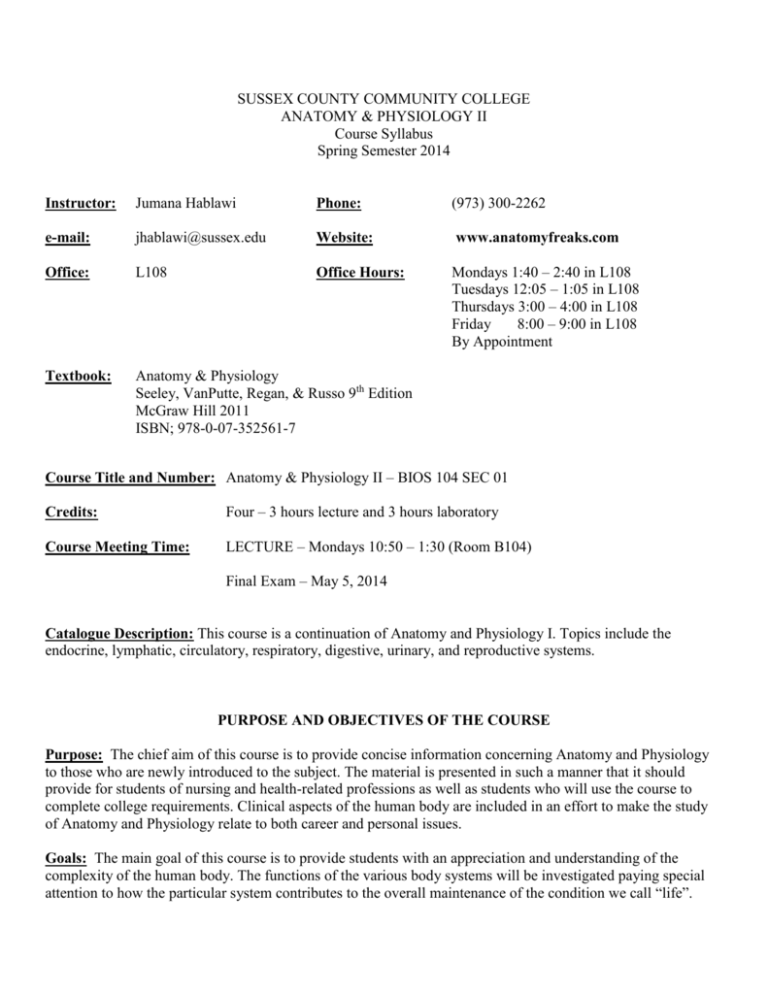
SUSSEX COUNTY COMMUNITY COLLEGE ANATOMY & PHYSIOLOGY II Course Syllabus Spring Semester 2014 Instructor: Jumana Hablawi Phone: (973) 300-2262 e-mail: jhablawi@sussex.edu Website: www.anatomyfreaks.com Office: L108 Office Hours: Mondays 1:40 – 2:40 in L108 Tuesdays 12:05 – 1:05 in L108 Thursdays 3:00 – 4:00 in L108 Friday 8:00 – 9:00 in L108 By Appointment Textbook: Anatomy & Physiology Seeley, VanPutte, Regan, & Russo 9th Edition McGraw Hill 2011 ISBN; 978-0-07-352561-7 Course Title and Number: Anatomy & Physiology II – BIOS 104 SEC 01 Credits: Four – 3 hours lecture and 3 hours laboratory Course Meeting Time: LECTURE – Mondays 10:50 – 1:30 (Room B104) Final Exam – May 5, 2014 Catalogue Description: This course is a continuation of Anatomy and Physiology I. Topics include the endocrine, lymphatic, circulatory, respiratory, digestive, urinary, and reproductive systems. PURPOSE AND OBJECTIVES OF THE COURSE Purpose: The chief aim of this course is to provide concise information concerning Anatomy and Physiology to those who are newly introduced to the subject. The material is presented in such a manner that it should provide for students of nursing and health-related professions as well as students who will use the course to complete college requirements. Clinical aspects of the human body are included in an effort to make the study of Anatomy and Physiology relate to both career and personal issues. Goals: The main goal of this course is to provide students with an appreciation and understanding of the complexity of the human body. The functions of the various body systems will be investigated paying special attention to how the particular system contributes to the overall maintenance of the condition we call “life”. Topics to be Included: 1. The Endocrine System 2. Blood 3. Heart 4. Circulation 5. Lymphatic and Immune System 6. Respiratory System 7. Digestion and Metabolism 8. Urinary System and Fluid Balance 9. Reproduction, Development, and Human Genetics 10. Homeostasis Course Competencies/Learning Outcomes: Upon completion of this course students should be able to: 1. Identify and locate the major organs of the endocrine, cardiovascular, respiratory, urinary, digestive, and reproductive systems. 2. Describe and identify the structure of the major organs in the endocrine, cardiovascular respiratory, urinary, digestive, and reproductive systems. 3. Describe the normal function of the endocrine, cardiovascular, lymphatic, respiratory, digestive, urinary, and reproductive systems and explain the physiological basis for these functions. 4. Analyze the interdependencies between the body systems and use examples illustrating how the cooperation between systems is necessary to maintain homeostasis. 5. Discuss the etiology and complex systemic effects of certain pathological conditions. 6. Use examples to illustrate how the interaction of two or more organ systems is required to accomplish specific significant functions. 7. Extrapolate the information, mechanisms, and concepts studied to analyze new problems. POLICIES OF THE COURSE Attendance: Regular attendance to all lectures is expected. Attendance will be taken each class meeting. In the event of an absence, students are responsible for the material covered in lecture. Method of Determining Grades: 4 Lecture exams 50 % Quizzes (Individual & Group) 15 % Comprehensive Final Exam 30 % Critical Thinking Group Work 5% Total 100 % (Class participation may add extra credit) *Note: The lowest grade from lecture exams 1 thru 4 will be dropped. A missed exam can be dropped only if the absence is excused and a letter from a medical professional may be requested. In addition, one lecture quiz with the lowest grade will also be dropped. *Note: The lecture portion of this course is worth 65% and the laboratory portion is worth the remaining 35%. - Each student MUST pass the Lab portion with at least a 55% . Grading System is as follows: A B+ B C+ C D F Excellent or Very Good or Good or above Average or Average or Poor or Fail or 92 – 100 88 – 91 83 – 87 78 – 82 71 – 77 65 – 70 Below 65 Make-up Exam Policy: There will be NO MAKEUP QUIZZES NOR MAKEUP CRITICAL THINKING GROUP WORK (under any circumstance). Makeup exams will only be given with a letter from a medical professional and only allowed once in a semester. The grade achieved on the relevant final exam will be used to replace a subsequent missed exam. The date of the exams will be arranged to accommodate the needs of the class and avoid conflicts if possible. Classroom and Laboratory Policy: According to school policy, there will be absolutely no eating or drinking in the classroom or laboratory. You are also permitted to have cell phones turned on during class or lab (please keep them on vibrate mode). Critical Thinking Group Work Requirement: The critical thinking group work requirement gets students to apply the information they are learning and to think more analytically about the information. While working as a group, students will learn to assist each other in putting facts together in order to reach the moment of true comprehension. Extra credit (optional – 5pts/activity towards grade of one lecture exam and/or final exam): Participation at a specified conference or exhibit. A reaction paper is required. Additional information will be provided in the near future. *Please note that the Last day to withdraw with a “W” grade is Tuesday, April 22nd ANATOMY & PHYSIOLOGY II COURSE SCHEDULE Spring 2014 Week No. Week of Lecture Schedule Laboratory Schedule 1 21-Jan Endocrinology (Chapter 17) Endocrinology (Exercise 27) 2 27-Jan Endocrinology (Chapter 18) 3 3-Feb Hematology(Chapter 19) / Cardiology (20) 4 10-Feb Cardiology (Chapter 20) 5 17-Feb Circulation (Chapter 21) Blood Vessels (Exercise 32,33A) 6 24-Feb Lymphatic (Chapter 22) Blood Vessels (Exercise 32,33A) 7 3-Mar Immunology (Chapter 22) Fetal Circulation Discussion / Blood Vessels (Exercise 32,33A) 8 10-Mar Respiration (Chapter 23) MIDTERM PRACTICAL/ Respiration (36, 37A) 9 17-Mar Spring Break - School Closed Spring Break - School Closed 10 24-Mar Respiration (Chapter 23) Respiration (Exercise 36, 37A) 11 31-Mar Digestion (Chapter 24) Digestion (Exercise 38/PIG) 12 7-Apr Digestion (Chapter 24) / Metabolism (25) Urology (Exercise 40) 13 14-Apr Urology (Chapter 26) Reproduction & Development (Exercise 42, 43, 44) 14 21-Apr Fluids, Electrolytes & Acid-Base (Chapter 27) Reproduction & Development (Exercise 42, 43, 44) 15 28-Apr Reproduction (28) / Development (29) (Some material will be covered in Lab) COMPREHENSIVE FINAL PRACTICAL 16 5-May FINAL COMPREHENSIVE EXAM Hematology (Exercise 29A) (WBC / Microscopy) Hematology (29A) (ABO/Hematocrit) & Heart Anatomy (30) Review ANATOMY & PHYSIOLOGY PRACTICAL II VALUES FOR EACH PRACTICAL EXAM Departmental Midterm Lab Practical Departmental Final Lab Practical (Comprehensive) = = 25 % 25 % TENTATIVE CONTENT OF LAB EXAMINATION WEEK OF 10-March MIDTERM PRACTICAL EXAM 28-April FINAL PRACTICAL EXAM Endocrine, Hematology, Cardiology Blood Vessels & Heart (“Trace a drop of Blood” question) All previous material Respiratory, Digestive, Urology Reproduction & Development INCLUSIVE Spring 2014 January 2014 I have read the course syllabi for BIO 104 Sec 01 and Professor Jumana Hablawi has reviewed its contents _________ Student Name _________________________________________________ Signature Date
